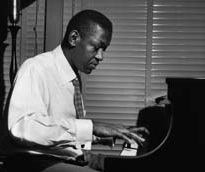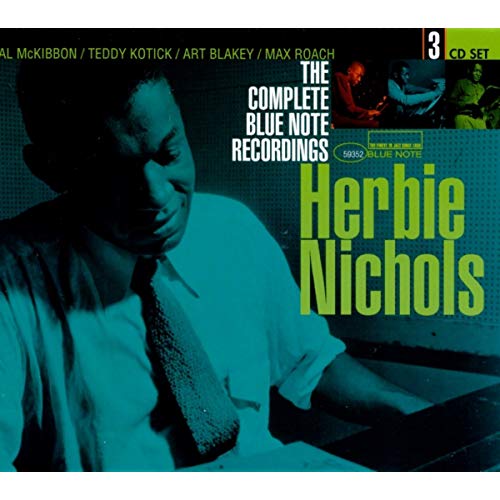Nick At T's – Herbie Nichols
One of Herbie Nichols' more Monk-esque compositions, which riffs on the upper extensions of m7♭5 chords. The bridge, however, is pure Nichols. A Piano Melody Transcription is available.
- Recording: Herbie Nichols - Complete Blue Note Recordings of Herbie Nichols
- Recorded on: August 7, 1955
- Label: Mosaic (MR5-118)
- Concert Key: E-flat
- Vocal Range: , to
- Style: Swing (uptempo)
- Piano - Herbie Nichols
- Bass - Al McKibbon
- Drums - Max Roach
0:00
0:00
Buy MP3
Video
- Description
- Historical Notes
- Solos
- Piano Corner
- Bass Corner
- Drum Corner
- Guitar Corner
- Inside & Beyond
- Minus You
Nick At T's is one of a few Herbie Nichols songs that show a strong influence of his friend Thelonious Monk. The A section melody repeats a single pattern over stepwise alternating chords. This pattern rises in thirds to the upper extensions of the underlying m7♭5 chords, reaching the 11th and resolving down to the 3rd. Gm7♭5 and Fm7♭5 are alternated this way three times, followed by an E♭ chord with a concluding whole-tone melodic phrase. This last phrase has an angular, distinctly Monkish sound.
The bridge breaks away from this Monkery, starting with an eighth-note line that has all the Nichols essentials: downward leaps followed by upward steps, sequential descending arpeggios, and ending on the third beat (in this case in the third measure). The same phrase, which outlines a II-V7-I in G major, is repeated in E♭ major. Though Herbie's original manuscript shows the second phrase of the bridge as an exact transposition of the first, on the recording he plays F and C at the end of this second phrase instead of the G and D that he wrote, on both in and out heads; our lead sheet reflects how he played it. The C section is the same as the A section.
The intro is a little different from many Nichols intros, not being based on any part of the head. It's a simple, staccato phrase over two measures of Bmaj7♯5 and two measures of E13(♯11); the bass does not walk here but instead alternates a whole note and two half notes. As with Furthermore and 'Orse At Safari, the intro is followed by a four-measure drum break and reappears as a coda, where it is bookended by two four-measure drum breaks.
A Piano Melody Transcription is available for the in and out heads; click on the Piano Corner tab for more details.
The bridge breaks away from this Monkery, starting with an eighth-note line that has all the Nichols essentials: downward leaps followed by upward steps, sequential descending arpeggios, and ending on the third beat (in this case in the third measure). The same phrase, which outlines a II-V7-I in G major, is repeated in E♭ major. Though Herbie's original manuscript shows the second phrase of the bridge as an exact transposition of the first, on the recording he plays F and C at the end of this second phrase instead of the G and D that he wrote, on both in and out heads; our lead sheet reflects how he played it. The C section is the same as the A section.
The intro is a little different from many Nichols intros, not being based on any part of the head. It's a simple, staccato phrase over two measures of Bmaj7♯5 and two measures of E13(♯11); the bass does not walk here but instead alternates a whole note and two half notes. As with Furthermore and 'Orse At Safari, the intro is followed by a four-measure drum break and reappears as a coda, where it is bookended by two four-measure drum breaks.
A Piano Melody Transcription is available for the in and out heads; click on the Piano Corner tab for more details.
This session from "The Complete Blue Note Recordings Of Herbie Nichols" was recorded at Rudy Van Gelder's legendary Hackensack Studio.
The title refers not to Nichols himself but to tenor saxophonist George "Big Nick" Nicholas; "T's" could mean Thelonious Monk's, as in Bertha Hope's Gone To See T. Herbie Nichols recorded only one take of this song.
Nick At T's was recorded in 1994 by bassist/cellist Buell Neidlinger on "Blue Chopsticks," an album of Nichols songs; another recording of this song comes from guitarist Richard "Duck" Baker's 1996 solo album "Spinning Song," also a Nichols tribute.
The title refers not to Nichols himself but to tenor saxophonist George "Big Nick" Nicholas; "T's" could mean Thelonious Monk's, as in Bertha Hope's Gone To See T. Herbie Nichols recorded only one take of this song.
Nick At T's was recorded in 1994 by bassist/cellist Buell Neidlinger on "Blue Chopsticks," an album of Nichols songs; another recording of this song comes from guitarist Richard "Duck" Baker's 1996 solo album "Spinning Song," also a Nichols tribute.
Our Piano Melody Transcription shows exactly how Herbie played the in and out heads. On the in head, he uses an unusual left hand accompaniment for the m7♭5 chords: holding the 7th with the thumb for the whole measure, he alternates between the flat fifth a third below on beat 1, and the flat fifth an octave lower (a 10th below the thumb) on beat 3. These lower notes are very soft; this is notated in the transcription.
For the out head CLIP, he takes this entire melody/harmony structure two octaves up, with a slight variation: a three-note voicing in the left hand (again with the 7th on top), dropping to D♭ on the third beat for both the G and F chords for an unusual sort of pedal point. The last two measures of the out head's A sections are one octave above where they are on the in head, not two octaves as in the rest of these sections. Herbie returns to the original octave in the bridge, varying the melody a little in the C section. All important articulations are shown in this transcription, especially small accent marks where certain melody notes stand out just a little from the notes around them.
For the out head CLIP, he takes this entire melody/harmony structure two octaves up, with a slight variation: a three-note voicing in the left hand (again with the 7th on top), dropping to D♭ on the third beat for both the G and F chords for an unusual sort of pedal point. The last two measures of the out head's A sections are one octave above where they are on the in head, not two octaves as in the rest of these sections. Herbie returns to the original octave in the bridge, varying the melody a little in the C section. All important articulations are shown in this transcription, especially small accent marks where certain melody notes stand out just a little from the notes around them.
Related Songs
Email Send Nick At T's to a friend
Send this page to a friend via email. Add your name or email in the first field. In the second, add one or more email addresses, separated by a comma.

Herbie Nichols
January 3, 1919 – April 12, 1963
Don Sickler "On January 3, 2019, we were at the Van Gelder Recording Studio celebrating Herbie's 100th birthday with his family and pianists Frank Kimbrough and Glenn Zaleski. Both Frank and Glenn each recorded a previously unrecorded Herbie Nichols composition, on the same piano Herbie played for his Blue Note sessions. These were the initial recordings that started my new project, the Herbie Nichols Centennial Project, which debuts January 3, 2024. Read more...
There was a problem.
...

